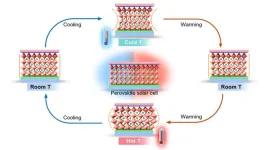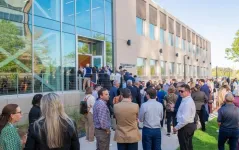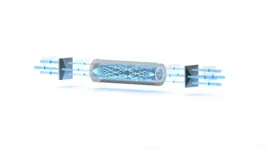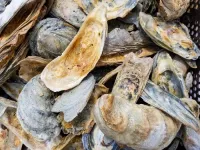(Press-News.org) Perovskite solar cells are highly efficient and low cost in production. However, they still lack stability over the decades under real weather conditions. An international research collaboration led by Prof. Antonio Abate has now published a perspective on this topic in the journal Nature Reviews Materials. They explored the effects of multiple thermal cycles on microstructures and interactions between different layers of perovskite solar cells. They conclude that thermal stress is the decisive factor in the degradation of metal-halide perovskites. Based on this, they derive the most promising strategies to increase the long-term stability of perovskite solar cells.
Perovskites are a wide class of materials with semiconducting properties suitable for energy conversion in a solar cell: the best of them, the metal-halide perovskites, already deliver efficiencies of up to 27%. The production of such thin-film solar cells requires particularly little material and energy, so solar energy could become considerably cheaper. However, when used outdoors, solar modules should provide a nearly stable yield for at least 20 to 30 years. And here, there is still a lot of room for improvement in perovskite materials.
Results from several years
An international research collaboration led by Prof. Antonio Abate has now published the results of several years of work in a review paper in the prestigious journal Nature Reviews Materials. Together with a team led by Prof. Meng Li, Henan University, China, and other partners in Italy, Spain, UK, Switzerland and Germany, they show that thermal stress is the decisive factor in the degradation of metal-halide perovskites.
Harsh conditions in "real life"
‘When used outdoors, solar modules are exposed to the weather and the seasons,’ says Abate. While encapsulation can effectively protect the cells from moisture and atmospheric oxygen, they are still exposed to quite large temperature variations day and night and throughout the year. Depending on the geographical conditions, temperatures inside the solar cells can range from minus 40 degrees Celsius to plus 100 degrees Celsius (in the desert, for example).
Effects of extreme temperature differences studied
To simulate this, the perovskite solar cells in the study were exposed to much more extreme temperature differences in several cycles: From minus 150 degrees Celsius to plus 150 degrees Celsius, and again and again. Dr Guixiang Li (then a postdoc at HZB, now a professor at Southeast University, China) investigated how the microstructure within the perovskite layer changed during the cycles and to what extent the interactions with the neighbouring layers were also affected by the temperature cycles.
Thermal stress inside the perovskite film and in between layers
Together, these factors affect the performance of the cell. In particular, the temperature cycles caused thermal stress, i.e. stress both within the perovskite thin film and between the different adjacent layers: ‘In a perovskite solar cell, layers of very different materials need to be in perfect contact; unfortunately, these materials often have quite different thermal behaviours,’ explains Abate. For example, plastics tend to shrink when heated, while inorganic materials tend to expand. This means that in each cycle the contact between the layers becomes worse. What is more, also local phase transitions and diffusion of elements into adjacent layers have been observed.
Most promising strategy
From this, the research teams have derived a strategy to increase the long-term stability of perovskite solar cells. ‘Thermal stress is the key,’ says Abate. The main thing, therefore, is to make the perovskite structures and the adjacent layers more stable against thermal stress, for example by increasing the crystalline quality, but also by using suitable buffer layers. The scientists highlight the importance of uniform test protocols for evaluating stability under temperature cycling and propose an approach to facilitate comparison between different studies.
END
Perovskite solar cells: Thermal stresses are the key to long-term stability
2025-02-21
ELSE PRESS RELEASES FROM THIS DATE:
University of Houston professors named senior members of the National Academy of Inventors
2025-02-21
University of Houston professors Birol Dindoruk, Megan Robertson and Francisco Robles Hernandez have joined the prestigious list of Senior Members of the National Academy of Inventors.
The University of Houston now has 39 faculty members in the NAI.
“We congratulate these three esteemed colleagues on being named NAI Senior Members,” said Ramanan Krishnamoorti, vice president for energy and innovation at UH. “This recognition is a testament to their dedication, research excellence and pursuit of real-world impact by knowledge and technologies. Their achievements continue to elevate the University as a leader in innovation and entrepreneurship.”
NAI Senior Members ...
Unraveling the mystery of the missing blue whale calves
2025-02-21
Only two blue whale births have ever been recorded in human history, both decades ago. This remains an extraordinary mystery given there used to be hundreds of thousands of blue whales before whaling started — even today blue whales number around 10,000 to 25,000 — and they give birth every two to three years.
Not only are births very stealthy, but calves are also only rarely sighted — far less than would be expected from their pregnancy rates. Calves closely follow their moms and are sighted as mother-calf pairs, but why are so few detected?
A new University ...
UTA partnership boosts biomanufacturing in North Texas
2025-02-21
The University of Texas at Arlington is joining forces with the Texas A&M Engineering Experiment Station (TEES) to operate the new National Center for Therapeutics Manufacturing Satellite Campus at Pegasus Park (NCTM2) in Dallas.
UTA’s Institute of Biomanufacturing and Precision Medicine (IMPRINT) is partnering with TEES on NCTM2, an extension of the National Center for Therapeutics Manufacturing (NCTM) in College Station. The collaboration will expand UTA’s biomanufacturing capabilities and provide NCTM2 with access to financial ...
Kennesaw State researcher earns American Heart Association award for innovative study on heart disease diagnostics
2025-02-21
Kennesaw State University researcher Chen Zhao has earned the 2025 American Heart Association Institutional Research Enhancement Award (AIREA) for his unique research on non-invasive blood flow prediction in cardiovascular disease diagnosis.
The $194,032 award will allow Zhao to continue developing technology aimed at evaluating Fractional Flow Reserve (FFR), a measurement used to diagnose coronary artery disease (CAD). According to the Centers for Disease Control and Prevention, CAD is the leading cause of death in the United States, with an average of 375,000 to ...
Self-imaging of structured light in new dimensions
2025-02-21
Researchers of photonics from Tampere University, Finland, and Kastler-Brossel Laboratory, France, have demonstrated how self-imaging of light, a phenomenon known for nearly two centuries, can be applied to cylindrical systems, facilitating unprecedented control of light’s structure with great potential for advanced optical communication systems. In addition, a new type of space-time duality is explored for powerful analogies bridging different fields of optics.
In 1836, Henry F. Talbot performed an experiment, where ...
Study highlights successes of Virginia’s oyster restoration efforts
2025-02-21
Virginia has made significant investments in the restoration of oyster reefs in the Chesapeake Bay, and now a study led by William & Mary’s Batten School & VIMS suggests those management practices are literally paying off in the Rappahannock River. The study, recently published in the Journal of Environmental Management, was led by Batten School of Coastal & Marine Sciences Ph.D. student Alexandria Marquardt, who presented the results to the Virginia Marine Resources Commission’s (VMRC) Shellfish Management Advisory Committee ...
Optimism can encourage healthy habits
2025-02-21
Do you see the glass as half empty or half full? If you rewind to the start of the COVID-19 pandemic, chances are you experienced some level of pessimism. And who could blame you? With social isolation, health concerns and economic uncertainty, fear and anxiety became a daily reality for many.
A team of researchers from Syracuse University and Michigan State University recently explored the personal characteristics that help people handle prolonged stressors, such as the pandemic. Led by Jeewon Oh, assistant professor of psychology in Syracuse University’s College ...
Precision therapy with microbubbles
2025-02-21
The targeted treatment of brain diseases such as Alzheimer’s, Parkinson’s or brain tumours is challenging because the brain is a particularly sensitive organ that is well protected. That’s why researchers are working on ways of delivering drugs to the brain precisely, via the bloodstream. The aim is to overcome the blood-brain barrier which normally only allows certain nutrients and oxygen to pass through.
Microbubbles that react to ultrasound are a particularly promising method for this sort of ...
LLM-based web application scanner recognizes tasks and workflows
2025-02-21
A new automated web application scanner autonomously understands and executes tasks and workflows on web applications. The tool named YuraScanner harnesses the world knowledge stored in Large Language Models (LLMs) to navigate through web applications in the same way a human user would. It is capable of working through tasks in a coherent fashion, performing the correct sequence of steps as required by, for example, an online shop. YuraScanner was tested against 20 web applications, unearthing 12 zero-day cross-site scripting (XSS) vulnerabilities. The technique behind YuraScanner as well as the tool itself have been developed by researchers ...
Pattern of compounds in blood may indicate severity of gestational hypertension and preeclampsia
2025-02-21
Preeclampsia, a complication of pregnancy characterized by high blood pressure and high levels of protein in the urine (proteinuria), indicating damage to the kidneys or other organ damage, is the main cause of maternal-fetal death in Brazil and the runner-up worldwide. In a Brazilian study published in the journal PLOS ONE, the pattern of substances present in patient blood samples varied according to the severity of the preeclampsia concerned.
The findings from the study, which was supported by FAPESP, ...










